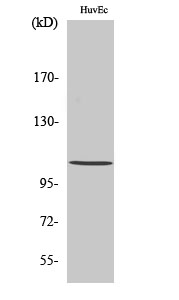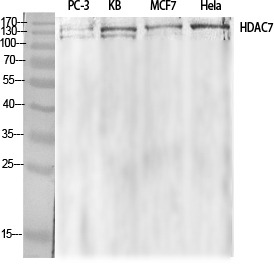Total Histone deacetylase 7a Cell-Based Colorimetric ELISA Kit
- Catalog No.:KA3291C
- Applications:ELISA
- Reactivity:Human;Mouse
- Gene Name:
- HDAC7
- Human Gene Id:
- 51564
- Human Swiss Prot No:
- Q8WUI4
- Mouse Swiss Prot No:
- Q8C2B3
- Storage Stability:
- 2-8°C/6 months
- Other Name:
- Histone deacetylase 7 (HD7) (EC 3.5.1.98) (Histone deacetylase 7A) (HD7a)
- Detection Method:
- Colorimetric
- Background:
- catalytic activity:Hydrolysis of an N(6)-acetyl-lysine residue of a histone to yield a deacetylated histone.,domain:The nuclear export sequence mediates the shuttling between the nucleus and the cytoplasm.,function:Responsible for the deacetylation of lysine residues on the N-terminal part of the core histones (H2A, H2B, H3 and H4). Histone deacetylation gives a tag for epigenetic repression and plays an important role in transcriptional regulation, cell cycle progression and developmental events. Histone deacetylases act via the formation of large multiprotein complexes. Involved in muscle maturation by repressing transcription of myocyte enhancer factors such as MEF2A, MEF2B and MEF2C. During muscle differentiation, it shuttles into the cytoplasm, allowing the expression of myocyte enhancer factors (By similarity). May be involved in Epstein-Barr virus (EBV) latency, possibly by repressing the viral BZLF1 gene.,miscellaneous:Its activity is inhibited by Trichostatin A (TSA), a known histone deacetylase inhibitor.,PTM:May be phosphorylated by CaMK1.,sequence caution:Intron retention.,similarity:Belongs to the histone deacetylase family. Type 2 subfamily.,subcellular location:In the nucleus, it associates with distinct subnuclear dot-like structures. Shuttles between the nucleus and the cytoplasm. Treatment with EDN1 results in shuttling from the nucleus to the perinuclear region. The export to cytoplasm depends on the interaction with the 14-3-3 protein YWHAE and may be due to its phosphorylation.,subunit:Interacts with HDAC1, HDAC2, HDAC3, HDAC4, HDAC5, NCOR1, NCOR2, SIN3A, SIN3B, RBBP4, RBBP7, MTA1L1, SAP30 and MBD3. Interacts with the 14-3-3 protein YWHAE, MEF2A, MEF2B and MEF2C (By similarity). Interacts with HTATIP and EDNRA. Interacts with KDM5B.,
- Function:
- regulation of cytokine production, negative regulation of cytokine production, chromatin organization, transcription,regulation of endothelial cell migration, positive regulation of endothelial cell migration, chromatin modification,regulation of ossification, regulation of cell migration, positive regulation of cell migration, regulation of interleukin-2 production, negative regulation of interleukin-2 production, regulation of locomotion, positive regulation of locomotion,regulation of blood vessel endothelial cell migration, positive regulation of blood vessel endothelial cell migration,regulation of transcription, negative regulation of cell differentiation, regulation of osteoblast differentiation, negative regulation of osteoblast differentiation, regulation of angiogenesis, positive regulation of angiogenesis, positive regulation of developmental process, negative regulation of mu
- Subcellular Location:
- Nucleus. Cytoplasm. In the nucleus, it associates with distinct subnuclear dot-like structures. Shuttles between the nucleus and the cytoplasm. Treatment with EDN1 results in shuttling from the nucleus to the perinuclear region. The export to cytoplasm depends on the interaction with the 14-3-3 protein YWHAE and is due to its phosphorylation.
- June 19-2018
- WESTERN IMMUNOBLOTTING PROTOCOL
- June 19-2018
- IMMUNOHISTOCHEMISTRY-PARAFFIN PROTOCOL
- June 19-2018
- IMMUNOFLUORESCENCE PROTOCOL
- September 08-2020
- FLOW-CYTOMEYRT-PROTOCOL
- May 20-2022
- Cell-Based ELISA│解您多样本WB检测之困扰
- July 13-2018
- CELL-BASED-ELISA-PROTOCOL-FOR-ACETYL-PROTEIN
- July 13-2018
- CELL-BASED-ELISA-PROTOCOL-FOR-PHOSPHO-PROTEIN
- July 13-2018
- Antibody-FAQs


